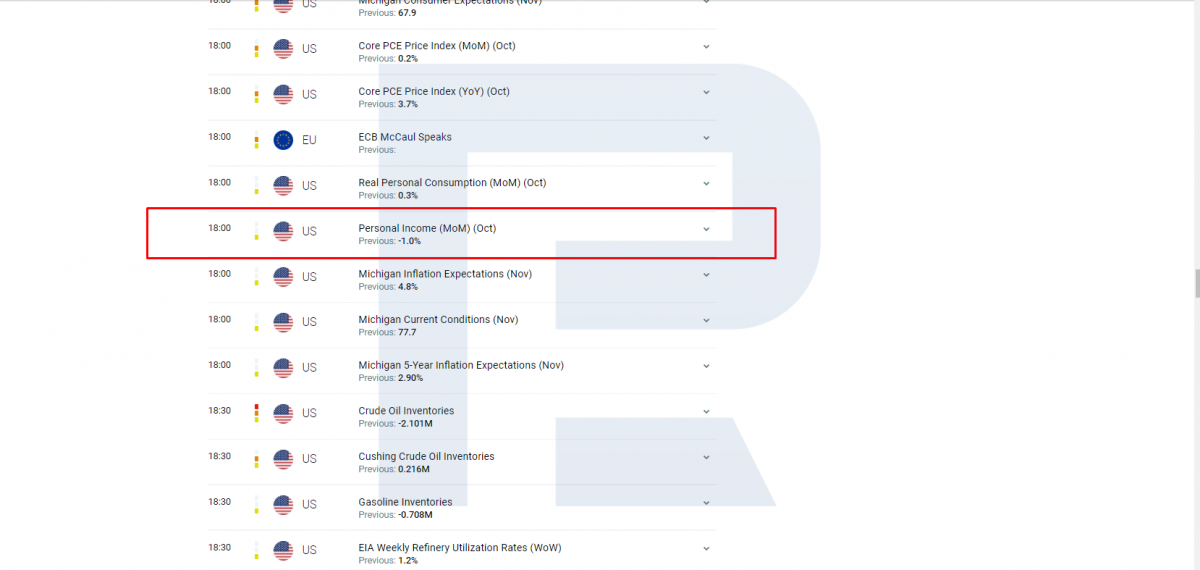How to Use Personal Income and Personal Spending in Forex

5 minutes for reading
This overview is devoted to two macroeconomic indicators — Personal Income and Personal Spending —and their influence on the currency market.
What is Personal Income
Personal Income represents monthly changes in the income of physical persons. This indicator assesses in percent the changes of the aggregate income of people in the country over a reporting month compared to the previous month. For calculations, income from several sources is used:
- Wage/salary
- Bonuses
- Income from owning real estate
- Income from holding financial assets
- Income from enterprises
- Subsidies and social payments
- Insurance, pension, etc.
In the USA, Personal Income is calculated and published by the Bureau of Economic Analysis (BEA), alongside Personal Spending.
Monthly changes of personal income is one of the key macroeconomic indicators that the BEA uses for assessing business activity in the country. Personal Income changes are published monthly in the Economic Calendar.

What is Personal Spending
Personal Spending demonstrates monthly changes in expenses of physical persons. It assesses in percent how aggregate expenses of people in the country have changed over the reporting month compared to the previous one. This includes all main expenses of the population:
- Spending on services
- Spending on durable and not goods
- Spending on banking transactions, commission fees, etc.
This indicator is also calculated monthly and published by the BEA alongside Personal Income. Consumer expenses are part of the GDP, hence, PS helps forecast its growth. Also, it is one of inflation growth indicators. Changing Personal Spending is published monthly in the Economic Calendar.

How do these indicators influence the currency market?
For analyzing the influence on the economy of a country, Personal Income and Personal Spending are used together. If the actual data turn out to be dramatically different from the forecast, volatility in the currency market can increase.
On average, these indicators change within 1-2%. Unexpected growth or decline by 3% or more can influence the rate of the US dollar against other currencies.
Both indicators normally have a moderate influence on currency rates. The influence will be most prominent if they grow or fall simultaneously.
If the price dynamics are of different directions — one indicator grows, the second one falls — market reaction can be ambiguous. Let us see how the market can react to simultaneous growth or falling of the indicators.
Growth
Confident growth of Personal Income and Personal Spending makes the USD become stronger. Such growth can heat up consumer market, support the growth of the GDP and speeding up of inflation.
As a result, to hold back overheating of the economy and decrease inflation, the Fed can raise the interest rate. Expectations of this possible increase in the interest rate attracts investors who buy the dollar.
Falling
Steep falling of both indices can make the USD fall against other currencies as well. Decreasing Personal Income and Spending demonstrates some unfortunate trends in the economy, which result in a decline of the GDP and inflation.
Later on, the Fed can liven up and support the economy by various stimulation measures and a decrease in the interest rate (if possible). On these expectations, investors will be selling the dollar.
Using the indicators for trading
Personal Income and Personal Spending can be used for trading in Forex alone or alongside other economic indicators.
Investment approach
For long-term investments in currencies, one needs to have a substantial capital and to be able to analyze in detail the dynamics of all economic indices of the country. For this, fundamental analysis is used: it helps to assess changes in Personal Income and Personal Spending alongside other data.
Positive dynamics of the indices (growth of both income and spending) means the US economy is doing good, and the dollar will be getting even stronger. If other fundamental indices confirm economic growth, investors will be interested in buying the dollar and will create a long-term uptrend by their demand.
Negative dynamics of both indices (a decline in income and spending) might lead to a downtrend in the USD. If the economic slow-down gets confirmed by other economic indices, investors will start selling the dollar in pair with other currencies, calculating on its subsequent decline, until the US economy stabilizes and starts growing again.
Short-term trading
This is the easiest way of using Personal Income and Personal Spending for Forex trading. Here, we use the opportunity to make a short-term trade when the published data differs a lot from the forecast. Steep growth of the indices can make the dollar stronger for a while, and a decline might provoke falling in the USD. In other words, we try to catch a short-term price momentum provoked by data publication.
For short-term trading, tech analysis is used — we need to estimate the current market trend and find support/resistance levels. As a result, we get the direction in which the quotations are most likely to go if the published data gives them extra momentum. If you trade with a large leverage, even a small movement on news can yield either a large profit or loss, so always control risks.
Get acquainted with the main principles of trading on news in the article "Trading News: How to Use Strategy and Form a Trading Plan?":
Bottom line
Personal Income and Personal Spending give an idea of monthly changes in lives of US people. As a rule, these indices are analyzed alongside other economic indices. They help assess current market activity and consumer sentiment, make conclusions about investment attractiveness of the USD or advantages of short-term trading.







